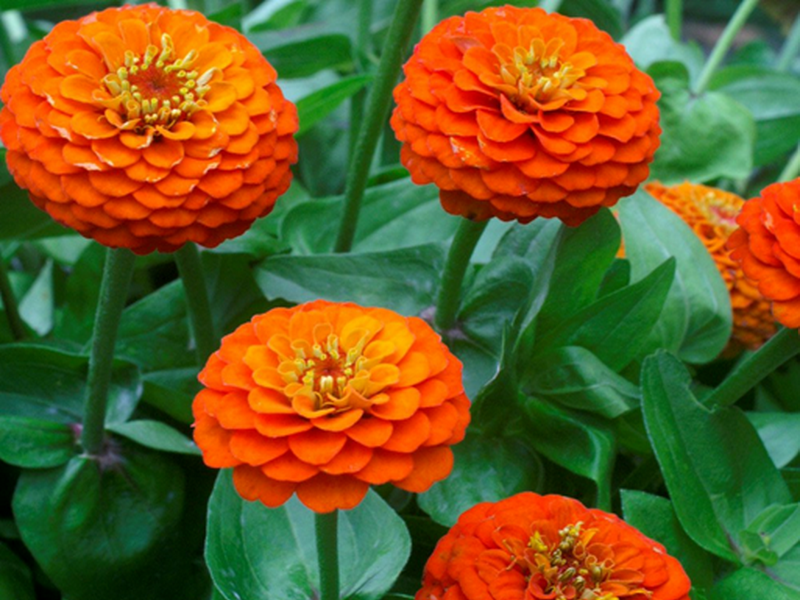Dwarf Zinnia Orange
Zinnia elegans dwarf-orange
Click here to download a PDF of this plant information page (for printing).

Sun Exposure: Full Sun
Season of Interest: Summer, Fall
Bloom Time: June - September
Bloom Color: Orange
Height: 12 to 24 in.
Spread: 12 in.
Spacing: 18 in.
Water Needs: Average
Maintenance: Very little
Soil Type: Clay, Loam, Sandy
Soil pH: Acidic, Neutral
Soil Drainage: Well drained
Pests: None
Diseases: Powdery mildew
Wildlife: Bees, Butterflies, Birds

Description:
Zinnias are a gift for gardeners in hot, humid climates where they thrive and grow easily. They are fast-growing, warm-season annual flowers that bloom with abandon, requiring only minimal care. Zinnias come in many bold colors. Dwarf varieties have a short, spreading, growth habit reaching only two feet in height. Zinnia elegans has lance-shaped, rough leaves. Flowers are rounded and daisy-like, often with double sets of petals. Zinnias flower all summer and into early fall, lasting in the garden from two to five months. Zinnias are most robust during the hot summer and the warmest autumn months. Zinnias don't need to be deadheaded, but your plants may have a longer bloom period if you do. Zinnias are true annuals, meaning they do not come back every year. You will need to plant new seeds every growing season. They can withstand some of the worst growing conditions but make sure to give zinnias full sun. For more information see:
plants.ces.ncsu.edu/plants/zinnia-elegans
Care and Growing Tips:
Zinnias, unlike many plants labeled as annuals that are perennial in the warm climates, are annuals everywhere. Zinnia plants can take a few weeks to become established, but then bloom from late spring through early fall. The vibrant, tropical colors of zinnias work well in a border, picking up the hues of other reds and oranges. They are also nice for adding dramatic color to a container. Zinnias are best planted in early to mid summer. Zinnias are not picky about their soil but need plenty of space for proper air circulation and disease prevention. The soil you use must be well-draining. If your soil is poor, you can add some compost to give the plants a boost, but zinnias will grow in even very bad soils. Zinnia roots can't tolerate damp soil. Excess moisture can lead to the flowers getting a fungal infection, like powdery mildew.
Plant zinnias in a spot with full sun. You will get the most prolific blooms in a sunny spot, and it will help to keep the leaves dry and thwart powdery mildew before it starts. Zinnias are very drought tolerant and don't usually need any supplemental watering. It doesn't matter how hot or humid the summer gets; zinnia plants just keep on blooming. Zinnias are easy-going plants, needing only occasional feeding with a well-balanced fertilizer.